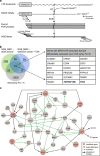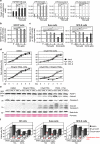Comprehensive identification of genes driven by ERV9-LTRs reveals TNFRSF10B as a re-activatable mediator of testicular cancer cell death
- PMID: 26024393
- PMCID: PMC4815979
- DOI: 10.1038/cdd.2015.68
Comprehensive identification of genes driven by ERV9-LTRs reveals TNFRSF10B as a re-activatable mediator of testicular cancer cell death
Abstract
The long terminal repeat (LTR) of human endogenous retrovirus type 9 (ERV9) acts as a germline-specific promoter that induces the expression of a proapoptotic isoform of the tumor suppressor homologue p63, GTAp63, in male germline cells. Testicular cancer cells silence this promoter, but inhibitors of histone deacetylases (HDACs) restore GTAp63 expression and give rise to apoptosis. We show here that numerous additional transcripts throughout the genome are driven by related ERV9-LTRs. 3' Rapid amplification of cDNA ends (3'RACE) was combined with next-generation sequencing to establish a large set of such mRNAs. HDAC inhibitors induce these ERV9-LTR-driven genes but not the LTRs from other ERVs. In particular, a transcript encoding the death receptor DR5 originates from an ERV9-LTR inserted upstream of the protein coding regions of the TNFRSF10B gene, and it shows an expression pattern similar to GTAp63. When treating testicular cancer cells with HDAC inhibitors as well as the death ligand TNF-related apoptosis-inducing ligand (TRAIL), rapid cell death was observed, which depended on TNFRSF10B expression. HDAC inhibitors also cooperate with cisplatin (cDDP) to promote apoptosis in testicular cancer cells. ERV9-LTRs not only drive a large set of human transcripts, but a subset of them acts in a proapoptotic manner. We propose that this avoids the survival of damaged germ cells. HDAC inhibition represents a strategy of restoring the expression of a class of ERV9-LTR-mediated genes in testicular cancer cells, thereby re-enabling tumor suppression.
Figures





Similar articles
-
Endogenous retrovirus drives hitherto unknown proapoptotic p63 isoforms in the male germ line of humans and great apes.Proc Natl Acad Sci U S A. 2011 Mar 1;108(9):3624-9. doi: 10.1073/pnas.1016201108. Epub 2011 Feb 7. Proc Natl Acad Sci U S A. 2011. PMID: 21300884 Free PMC article.
-
Utility of next-generation RNA-sequencing in identifying chimeric transcription involving human endogenous retroviruses.APMIS. 2016 Jan-Feb;124(1-2):127-39. doi: 10.1111/apm.12477. APMIS. 2016. PMID: 26818267 Review.
-
LTR12 promoter activation in a broad range of human tumor cells by HDAC inhibition.Oncotarget. 2016 Jun 7;7(23):33484-97. doi: 10.18632/oncotarget.9255. Oncotarget. 2016. PMID: 27172897 Free PMC article.
-
At least 50% of human-specific HERV-K (HML-2) long terminal repeats serve in vivo as active promoters for host nonrepetitive DNA transcription.J Virol. 2006 Nov;80(21):10752-62. doi: 10.1128/JVI.00871-06. J Virol. 2006. PMID: 17041225 Free PMC article.
-
Reactivation of endogenous retroviral elements via treatment with DNMT- and HDAC-inhibitors.Cell Cycle. 2018;17(7):811-822. doi: 10.1080/15384101.2018.1442623. Epub 2018 Apr 30. Cell Cycle. 2018. PMID: 29633898 Free PMC article. Review.
Cited by
-
Novel function of U7 snRNA in the repression of HERV1/LTR12s and lincRNAs in human cells.Nucleic Acids Res. 2024 Sep 23;52(17):10504-10519. doi: 10.1093/nar/gkae738. Nucleic Acids Res. 2024. PMID: 39189459 Free PMC article.
-
Binding of NF-Y to transposable elements in mouse and human cells.Mob DNA. 2025 May 9;16(1):22. doi: 10.1186/s13100-025-00358-9. Mob DNA. 2025. PMID: 40346696 Free PMC article.
-
Endogenous Retroviruses Transcriptional Modulation After Severe Infection, Trauma and Burn.Front Immunol. 2019 Jan 8;9:3091. doi: 10.3389/fimmu.2018.03091. eCollection 2018. Front Immunol. 2019. PMID: 30671061 Free PMC article.
-
Microorganisms as Shapers of Human Civilization, from Pandemics to Even Our Genomes: Villains or Friends? A Historical Approach.Microorganisms. 2021 Dec 6;9(12):2518. doi: 10.3390/microorganisms9122518. Microorganisms. 2021. PMID: 34946123 Free PMC article. Review.
-
TNRC18 engages H3K9me3 to mediate silencing of endogenous retrotransposons.Nature. 2023 Nov;623(7987):633-642. doi: 10.1038/s41586-023-06688-z. Epub 2023 Nov 8. Nature. 2023. PMID: 37938770 Free PMC article.
References
Publication types
MeSH terms
Substances
LinkOut - more resources
Full Text Sources
Other Literature Sources
Medical

